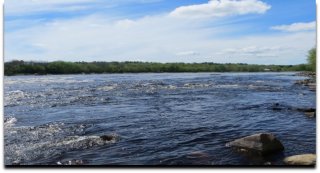EPA Research in Maine
EPA researchers are working hard to protect communities across the nation. Learn about some of the work EPA researchers are doing in Maine.
- One Health Assessment: Fish Returning to the Penobscot River
- Working with Tribal Partners to Restore Fisheries in Northern Maine
- Stream Monitoring Network
For more EPA work, see EPA in Maine.
One Health Assessment: Fish Returning to the Penobscot River

Many fish species have returned to the Penobscot river after a long effort to restore the river's fisheries. However, with the return of the fish came the concern of whether they carry contaminants that may pose various health concerns to tribal members and wildlife. EPA researchers worked with the Penobscot Indian Nation and the Agency for Toxic Substances and Disease Registry to gain a better understanding of the contaminant levels in fish that return to the river each year to spawn. Read One Health Assessment: Fish Returning to the Penobscot River.
Working with Tribal Partners to Restore Fisheries in Northern Maine
EPA collaborated with Tribal, state, federal, and international partners to develop a cloud-based population diversity database of Atlantic salmon DNA as part of biodiversity and sustenance fishing restoration efforts of the Houlton Band of Maliseet Indians tribal waterways in Northern Maine. Read Working with Tribal Partners to Restore Fisheries in Northern Maine.
Stream Monitoring Network
EPA's Office of Research and Development is working with EPA regions, states (including Maine), Tribes, river basin commissions and other entities to establish Regional Monitoring Networks for freshwater wadeable streams. The objectives are to collect long-term biological, thermal, hydrologic, physical habitat and water chemistry data to document baseline conditions across sites and detect long-term changes. This data can be used for many purposes, including informing water quality and biological criteria development and setting protection planning priorities, refining lists of biological, thermal and hydrologic indicators, and detecting trends in commonly used water quality and biological indicators.
